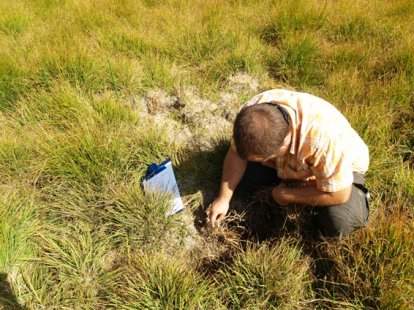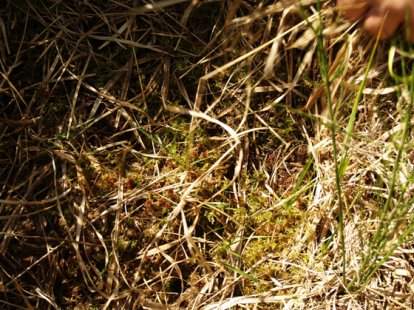
Photo 1. Assessing the survival rate of peat moss transplants in sample
plots at Trstenik Mire. Results show that the peat moss has survived the
dry summer period and continues to grow, to a greater or lesser extent,
in all sample plots to which it was transplanted last autumn
ASSESSING THE SURVIVAL RATE OF PEAT MOSS TRANSPLANTS IN SAMPLE PLOTS
On 16 September 2011, as part of our regular visit to
Trstenik Mire, we reassessed the survival rate of peat moss transplants
in sample plots following a summer that was relatively unfavourable for
peat moss growth. The aim of this year’s second assessment (the first
took place in the spring) was to determine the percentage of surviving
and green shoots out of the total mass of peat moss transplanted last
autumn. In the spring, we assessed that the peat moss transplants successfully
survived the winter and continue to grow (see the report on our Web pages).
The second assessment confirms that the peat moss transplants have survived
the dry summer period and are growing in all samples plots to which they
were transplanted. We roughly estimated the percentage of green and dry
shoots of peat moss in each sample plot. The survival rate is in the range
of 60% to 95%
Sample plot no. 1 – a survival rate of 75%
Sample plot no. 2 – a survival rate of 80%
Sample plot no. 3 – a survival rate of 95%
Sample plot no. 4 – a survival rate of 98%
Sample plot no. 5 – a survival rate of 60%
Sample plot no. 6 – a survival rate of 70%
Sample plot no. 7 – a survival rate of 75%
Sample plot no. 8 – a survival rate of 95%
Sample plot no. 9 – a survival rate of 85%
We established that peat moss died only in the most exposed
and dry parts of sample plots, and that the light dry-grass covering most
likely had a vital role in peat moss survival. However, this type of covering
should be used with caution, as we noticed that peat moss also withered
and rotted in places where the grass covering was thicker, creating a
compact layer overlaying the hollow parts of sample plots. The conclusion
is that only a minimal quantity of dry-grass covering should be used in
future transplantation attempts and that the covering should be loosened
from time to time.

Photo 2. Fresh peat moss shoots that survived the winter and dry summer



